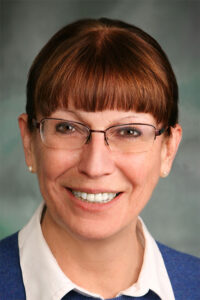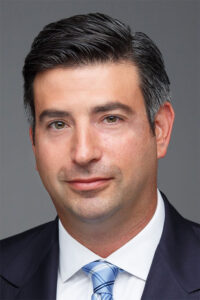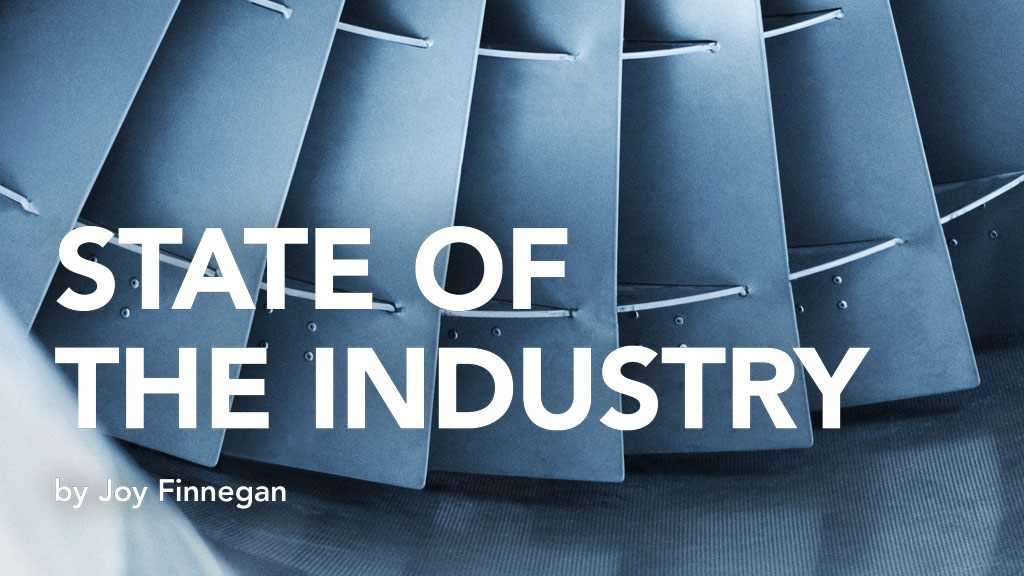Industry Leaders Discuss Key Issues Facing Aviation MRO
The annual Aviation Maintenance magazine State of the Industry Leadership Insights has always attracted great interest from the MRO industry. We contacted a wide range of industry leaders, from airline MROs to independents, industry associations, airplane manufacturers and engine OEMs.
We received replies from chairmen and chief executives, vice presidents and directors. All have been candid with their answers.
Many of the responders answered all of the questions, while some answered those that they felt were most relevant to their own business.
We hope that you find this survey enlightening and useful to your own business activities. Huge thanks to all of these busy executives who took the time to answer our questions. We greatly appreciate your participation and sharing your insights with our readers.
Stan Deal, Boeing Global Services

- 1. What technology advancements are needed in the aviation maintenance industry?
- We are experiencing revelations in technology today that will change the formula and timeline for innovation within and beyond the aerospace industry, including maintenance. Ultimately, these advancements should do two things for our customers: increase the efficiency and capability of their platforms, and decrease operational costs. At a granular level, this could look like a new digital tool that uses data analytics to predict a maintenance issue and then prescribe a comprehensive plan to address it. More broadly, technology advancements like virtual reality and artificial intelligence will augment human decision-making to transform the way maintenance is predicted and performed. Our responsibility is to two-fold: Invest in the technologies that address our customers’ greatest needs, and enable the talent that will discover, create and support future aerospace technology innovation.
- 2. What innovation that your company has made in the last year are you most proud?
- Boeing has been pioneering aerospace innovation for more than 100 years – I feel an incredible sense of pride and responsibility to be a part of its legacy and innovative path forward.
On July 1, 2017, Boeing Global Services was launched as a third Boeing business unit alongside Defense, Space & Security and Commercial Airplanes. It was a big, bold businesses model transformation that has significantly expanded capabilities and offerings for the aerospace services industry. The new business model has redefined the interdependencies of Boeing, including our suppliers and industry partners, to introduce services that drive faster flow times, lower operational costs, and enhanced end-to-end reliability and efficiency. I’m proud to say that we’re learning faster than ever before – our business is growing faster than the average aerospace services market growth of 3.5 percent, and we’re showing customers around the globe that Boeing is a long-term, complete lifecycle innovator. - 3. Name and explain the hardest challenges you will face this year as a leader.
- The most important challenge that I face – and it’s shared by leaders across aerospace and many other industries – is the global competition for talent. Technology is innovated and advanced by talented people; challenges are overcome by tenacious teams; and change is best navigated through the minds of our employees. As industry-leading MRO technology evolves, so must the dynamics of how we approach and apply it. This requires a great deal of forethought – how do we re-skill talent? How do we preserve knowledge? How do we focus our community investment and presence to inspire future talent? Our hardest MRO-related challenges will be solved by Global Services employees. I believe we have the right people and structure in place to tackle them, and I think we’re focused on the right services capabilities.
- 4. There is a saying, “The only constant is change.” How does your company address change in our industry?
- Boeing wants to lead and embrace change when it’s in the best interest of our customers. In the MRO realm, this means working alongside our suppliers, operators and customer maintenance personnel to fully understand and co-own the challenges they face. For example, when an existing process to get parts in the hands of maintainers is not complying with their schedule, we’ve identified flexibility in the system to give them an immediate, tailored solution. We’re also being conscious to address change holistically. Rather than changing a maintenance process to resolve a specific issue, we evaluate whether or not that process can be evolved to optimize maintenance for an entire airline. Boeing is at the forefront of providing digital solutions that help customers drive operational efficiencies and asset utilization to reduce costs. We’ll continue to evolve and grow our digital offerings to help customers improve readiness rates and productivity.
- 5. What are the biggest barriers your company faces in your quest for success (government, regulations, OEMs, personnel)?
- Global Services was established to break down barriers and provide Commercial and Government customers with unprecedented value and the best experience in the industry. We’re taking a hard look at things like government and FAA regulations, data sharing and personnel demand in the context of how we can bring the breadth and depth of Boeing’s resources to the industry in the form of comprehensive solutions. We’re making organic investments to unlock the potential of the entire enterprise and to understand our customers’ needs from multiple perspectives. This is allowing us to get creative and bring the best of Boeing to any obstacle.
The flow of data is a complexity facing our industry, and one that Global Services is addressing with the recent launch of Boeing AnalytX – Self-Service Analytics. We’ve been sharing data for the benefit of the industry for more than 20 years. The launch of Self-Service Analytics is a step toward bringing our customers a systemic way to share and use data for the benefit of the industry. Subscribing customers can access to their own data across their subscribed applications. They will be able to use the Self-Service Analytics tools to explore data within an application data set or across applications they currently use. - 6. Is the shortage of maintenance personnel truly here? If so, how is it impacting your company and how are you addressing the problem?
- Boeing’s Pilot & Technician Outlook (PTO) represents the global demand forecast for pilots, technicians and cabin crew based on future fleet growth projections over the next 20 years. Total technician demand is based on the amount of maintenance required over the life of various aircraft types. Global Services looks at demand holistically to determine how we can leverage the strength and possibility within each of our capability focus areas (Supply Chain; Digital Aviation & Analytics; Engineering, Modifications and Maintenance; and Training and Professional Services) to unlock efficiencies that support and mitigate potential issues related to demand. For example, our Airplane Health Management (AHM) tool, powered by Boeing AnalytX, provides real-time situational awareness and maintenance status of an operator’s entire fleet to avoid unplanned maintenance, thus preserving personnel resources.
- 7. What should we be wary about in our industry during the next five years?
- There is a lot of work being done in the name of innovation, but we must have the courage to step away from anything that does not create value for our customer and drive positive momentum for our industry. For Global Services, this means approaching every idea with unconstrained perspective and really listening to customers, whether concerns center on reams of data or a single part. Embracing the idea that innovation can happen at every level unlocks incredible potential.
Russell Ford, StandardAero

- 1. What technology advancements are needed in the aviation maintenance industry?
- The biggest technology opportunities lie in the new generation aircraft engines that are more fuel efficient, smarter, have longer maintenance intervals and allow for more on-condition and on-wing maintenance and field services versus traditional shop visits and heavy off-wing overhauls. Data analytics, including predictive engine health monitoring and analysis that make use of on-condition sensors and information, will also be extremely important for the industry. Finally, advanced materials and additive manufacturing capabilities are continuing to develop in our industry. Certifying repairs and services for these types of engine components will require new thinking and new technologies.
- 2. What innovation that your company has made in the last year are you most proud?
- During 2017, we are most proud of our innovative efforts to complete four acquisitions to meet the growing demand and capacity requirements for our services. The first acquisition was Jet Aviation Specialists, a component repair shop in Miami, in February. Second was PAS Technologies, another component repair and manufacturing company with shops in the U.S., Asia and Europe, in May. The third was the acquisition of the Lockheed Martin business at Kelly Air Center, in San Antonio, during August, which expanded our overall capacity and test cell capabilities. Finally, the fourth was the acquisition of Vector Aerospace, a large, diversified MRO company that greatly increases the scale of our global capabilities, from Airbus Industries. These additions to the StandardAero portfolio align with our long-term growth strategy and give us new customers, new platforms and new services to offer to customers. As a result of our actions in 2017, we grew the employee base from 3,800 employees to more than 6,000 employees across 40 sites in 12 countries on 5 continents.
- 3. Name and explain the hardest challenges you will face this year as a leader.
- The hardest challenge I expect to face in 2018 as a leader is to ensure the successful integration of these acquisitions into our company, most importantly the seamless continuation and expansion of our strong company culture across a substantially larger enterprise.
- 4. There is a saying, “The only constant is change.” How does your company address change in our industry?
- At StandardAero, we embrace change through a continuous improvement (CI) culture and commitment throughout the entire organization. At any given time, there are more than 400 employee-led CI projects underway in our company. In the past few years, these efforts have produced tens of millions of dollars in process improvements. But, more importantly, these efforts challenge our employees to find new ways to look at things and new ways to solve problems.
- 5. What are the biggest barriers your company faces in your quest for success (government, regulations, OEMs, personnel)?
- The biggest barriers for us include challenges in receiving government delivery orders or government furnished materials and issues in the OEM supply chain – particularly around key parts availability and reliability.
- 6. Is the shortage of maintenance personnel truly here? If so, how is it impacting your company and how are you addressing the problem?
- Developing, finding, hiring skilled technicians is one of the biggest challenges we collectively face in the MRO industry. While currently sufficient, the pipeline for our future technical workforce development is a concern and we are going to need additional people. We have sufficient tools, machines and facilities but the constraining issue in the future is going to be qualified technicians, along with OEM parts supply and availability.
Our efforts to develop technicians range from apprenticeship programs with local colleges, to mentoring students at various trade schools, to internships in our repair shops and helping local community colleges develop programs and occupational standards to establish certification programs for A&P mechanics and other technicians.
At StandardAero, we also actively recruit veterans and find them to be very well-suited for many of our maintenance and technical roles. In fact, 21.5% of our U.S. workforce today is either retired or active/reserve military veterans. In addition, we are expanding operations in places like San Antonio, where there is an embedded pool of military and government trained people who are qualified and available in those locations.
In addition, we are bringing in people from ancillary industry sectors, like automotive and industrial manufacturing companies, and training people to cross over, learn quickly and get trained as A&Ps. We have also donated tooling, engines and equipment to help schools provide hands-on training. Finally, we partner with trade associations, like GAMA and NBAA to promote STEM education and participate in programs to attract young people to careers in aviation. - 7. What should we be wary about in our industry during the next five years?
- What keeps me up at night is our ability to attract talented young people into our industry and create the draw for the next generation of professionals. Can we recreate the excitement of the 1960’s-1970’s “Space Race” in the 21st Century? That is the challenge. Together, we need to find ways to fuel new focus, fresh ideas and new dreams to spark and capture the interest of the next generation of aerospace engineers and technicians.
Leo Koppers, MTU Maintenance

- 1. What technology advancements are needed in the aviation maintenance industry?
- Unsurprisingly, we believe the next technology advancements in the MRO business will be driven by digitalization and this is where the greatest development will take place across the industry. At MTU, we’re working towards full data integration throughout the entire product lifecycle and as a result, improving the predictability of engines. We expect this to benefit both the MRO and OEM aspects of MTU’s business. Data availability and automated analysis will be key here.
- 2. What innovation that your company has made in the last year are you most proud?
- Recently, we started integrating MTU’s MRO data – such as engine monitoring data and inspection data – within a common MTU group-wide platform. This can be used on either side of MTU’s business units. The OEM side will be able to use the data to further improve our engine design. And on the MRO side, we can use the data to further improve maintenance costs for our customers.
- 3. Name and explain the hardest challenges you will face this year as a leader
- We need to cope with the growth in the MRO industry, while the OEM side of the business is delivering more new engines than ever before. In particular, the availability of spare parts is a concern and puts high pressure on the total supply chain. Delays could lead to engine turn time increases; we need to manage this process in cooperation with our leasing arm, MTU Maintenance Lease Services B.V.
- 4. There is a saying, “The only constant is change.” How does your company address change in our industry?
- That is very true. Our approach to change is to have a broad basis for growth. For instance, one challenge for us as an independent service provider is the increasing OEM coverage for next generation engines. MTU Maintenance has adapted its strategy to this market situation and cooperates with OEMs in their aftermarket networks, for instance on the PW1100G-JM, as well as airlines such as Lufthansa Technik and China Southern. But our greatest focus is on our broad independent portfolio and continually developing and improving our highly-customized and integrated solutions for customers.
- 5. What are the biggest barriers your company faces in your quest for success (government, regulations, OEMs, personnel)?
- We are incredibly fortunate that the global engine MRO market is very healthy and that strong growth is expected well into the next decade. As such, one of the bigger challenges will be serving this growth. We are increasing capacity levels at all our existing facilities in 2018. For instance, we will further invest in our Chinese facility: its capacity of 300 shop visits per year is to be expanded capacity by another 50% again within the coming years so as to keep up with local market growth as well as to accommodate any new programs in due course.
Furthermore, we created a new facility, Engine Maintenance Europe, or EME Aero for short, a joint venture Lufthansa Technik last year. According to current plans, the facility will be operational in 2020 and have an annual capacity of over 400 shops visits. It will service the new PW1000G-series geared turbofan engines as part of the OEM network. - 6. Is the shortage of maintenance personnel truly here? If so, how is it impacting your company and how are you addressing the problem?
- We would not necessarily speak of a shortage, however, there is definitely a need for qualified personnel within the industry. Over the past year, we have been looking to hire more maintenance technicians at our locations in Berlin and Hannover in particular. However, due to our expanding engine and product portfolio, we also regularly look for engineers, sales people and customer account managers, among others, from all countries and backgrounds – also from outside aviation.
Furthermore, we run a global company. At our location in Zhuhai, China, for instance, we are not noticing any particular shortage in qualified applicants. - 7. What should we be wary about in our industry during the next five years?
- One challenge in coming years is likely to be parts and supply chain related. With the OEM ramp up on new generation engines and current generation engines maturing and going through shop visits, there will be enormous parts demand and significant pressure on the parts supply chain.
Joe Sylvestro, Pratt & Whitney

- 1. What technology advancements are needed in the aviation maintenance industry?
- Across the industry, big data continues to be a hot topic. Data is critical to improving the MRO business decision making process. Better data means more accurate analysis – better decisions, operational efficiencies, cost reductions, and reduced risk Big data has been a large focus for Pratt & Whitney for many years. As part of EngineWise, we’re using state-of-the art data analytics and real-time intelligence to proactively monitor the health of our engines in order to predict and prevent engine disruptions before they occur.
We understand that no two operators are the same and have different engines, aircraft, geographic routes, operational needs and environmental conditions. Analytics technologies allow us to use global fleet data while monitoring the unique environments in which individual aircraft fly.
New data acquisition and predictive analytics tools enable both operators and Pratt & Whitney to make recommendations that reduce operational disruptions and increase aircraft utilization. - 2. What innovation that your company has made in the last year are you most proud?
- One area where we are growing and innovating is with our EngineWise services portfolio, which we announced in April 2017. The advantage of EngineWise comes in our commitment to advance and integrate our engine expertise and fleet intelligence into service offerings for our customers that allow them to optimize engine performance to keep their businesses running smoothly and efficiently. Essentially, EngineWise better represents what we offer, and how we’re evolving to improve the predictability, reliability and health of our customers’ fleets.
- 3. Name and explain the hardest challenges you will face this year as a leader.
- There are many tough leadership challenges we will face this year and high on the list is how to keep a large and distributed organization aligned and efficiently working on its priorities. Between existing customer commitments, pursuit of advancing customer service, and introduction of new product lines, maintaining efficient alignment is a challenge for any company. A couple of areas we have implemented changes to help with these challenges are in the area of clear leadership communication of the mission – what needs to be done and why is it important. The commander’s intent will help leadership across and down the organization to align and work together to accomplish the priorities. Additionally, a process called Policy Deployment helps to flow the company’s top priorities down and identify every organization’s role and responsibility to support and ultimately achieve these objectives. This process helps define the owner for leading a particular initiative but also clearly identifies the key cross-functional stakeholders and their deliverables. Ultimately, these challenges and techniques are about communication and clearly setting priorities to enable the organization to address them.
- 4. There is a saying, “The only constant is change.” How does your company address change in our industry?
- Pratt & Whitney is constantly innovating and adapting to change due to the nature of the aerospace industry. For example, one of the biggest challenges in the industry today is the skills gap. The threat of automation isn’t that it will replace all jobs, but that people will need to have the right skills to fill the jobs that will be created as business needs evolve. With the increasing rate of change, companies and their employees must be willing to embrace change and continue to learn to stay competitive.
- 5. What are the biggest barriers your company faces in your quest for success (government, regulations, OEMs, personnel)?
- Our biggest challenge at Pratt & Whitney is two-fold: Hiring skilled employees for the jobs of the 21st Century, ranging from engineers to mechanics to inspectors, but also managing our unprecedented engine ramp. We will produce and overhaul engines at a rate we haven’t seen since the early 1980s, and we have invested $1.3B in our facilities to handle the market dominance we fully expect to achieve in our new products, including the F-35 and GTF engines, while also continuing to support our operational commercial engines.
- 6. Is the shortage of maintenance personnel truly here? If so, how is it impacting your company and how are you addressing the problem?
- Pratt & Whitney is in an age of tremendous growth. We are recruiting to fill 25,000 positions across all functions globally by 2025. And we are well on our way.
We view work in the aerospace field as a higher calling, because what we do really matters to the world. Getting top talent that really identifies and believes in that higher calling, and in the opportunities that exist in aerospace, is really the challenge. That’s why it’s so important for us to work closely at the grassroots level – in the high schools and college level – where students really start to see the potential and fulfillment that comes from working in the STEM fields, and with a global aerospace manufacturer like Pratt & Whitney.
Our dedicated talent acquisition team utilizes new digital tools to find active and passive candidates. We have many sourcing and outreach strategies such as a robust campus recruitment program, a strong presence at key diversity conferences, participation with Paradigm for Parity Coalition, USBLN and more. Additionally, we value working with veterans groups, whose skills are very transferable to the type of work we do. We also have a strong employee referral program. Our employees are great brand ambassadors for us. Social media has also become a very important component of our process and we utilize our @PWCareers Twitter account every day to highlight job opportunities. - 7. What should we be wary about in our industry during the next five years?
- As we look out five years from now, there is unprecedented projected growth in shop visits. At Pratt & Whitney, we are laser focused on supplier capacity and performance. We need to ensure that we have a strong supply base in place that is performing at gold standard levels so we can make our commitments and deliver to customers. The GTF engine has complex parts and repair processes – we are looking to ensure we have strategic companies in our supply base that can help us take on this monumental task of capitalizing and investing in the GTF MRO network.
Brian Sartain, AAR

- 1. What technology advancements are needed in the aviation maintenance industry?
- AAR doesn’t think there’s a lack of technology advancements available in the industry, but the lack of practical application that the aviation maintenance industry struggles with. There are various technologies such as advanced diagnostic algorithms, IoT, wearables, mobile devices, chatbots that have been available for some time. Each one of these technologies can significantly improve operational efficiencies under the right implementation circumstances, but the substantial investment required per implementation have slowed adoption.
- 2. What innovation that your company has made in the last year are you most proud?
- AAR has been working on modernizing our custom MRO ERP for the last couple of years. Since last year, we rolled out the “1MRO mobile app” on both iOS and Android platforms. This application allows our Project Managers to access real-time information using their mobile devices. In addition to this, our mechanics and inspectors can view their training records, authorizations with just a few clicks. They can also register for upcoming training classes. We are very excited about the next level of integration with our customer portals, to enhance the customer experience.
- 3. Name and explain the hardest challenges you will face this year as a leader.
- The shortage of qualified aviation mechanics is the biggest challenge I will face this year as we expect the shortage to intensify as demand for services increase and the work force ages. Major employment actions by airlines have already had a significant impact on our workforce and the supply of contractors is limited. AAR is developing an even more robust approach to address the situation in addition to what we have done already – listed below.
- 4. There is a saying, “The only constant is change.” How does your company address change in our industry?
- By staying on top of industry trends, staying close to our customers and developing strategies that take advantage of opportunities as they present themselves. Anticipating and reacting to industry trends is how AAR has stayed in business for more than 60 years and remains financially stable. For example, we built our state-of-the-art Rockford MRO to accommodate wide-body and new-generation aircraft like the 787, A350 and A380 in anticipation of future demand, but are currently utilizing that space for current generation aircraft.
- 5. What are the biggest barriers your company faces in your quest for success (government, regulations, OEMs, personnel)?
- For us, addressing the personnel shortage is key. Since government education policy and funding moved away from technical schools/training and to four-year colleges, we’ve seen a shortfall of high-quality technical training for jobs like AMTs. The current FAA requirements for AMT certification makes it challenging to attract new candidates to the occupation.
Global expansion of MRO facilities into emerging markets is also a challenge. While independent MROs like AAR can bring and share our expertise, we need to find local partners with strong workforce and cultural knowledge of the region to be successful. Luckily, AAR has found that partner in our JV with Indamer to develop a new MRO facility in central India that will be operational by early next year. - 6. Is the shortage of maintenance personnel truly here? If so, how is it impacting your company and how are you addressing the problem?
- Aerospace has dealt with a shortage of experienced aircraft maintenance workers for over a decade. Data from ARSA suggests that the impact is already being felt: More than 80 percent of respondents to ARSA’s 2018 member survey report difficulty finding qualified technicians and more than two thirds of responding companies have unfilled positions.
AAR has also done our best to partner with technical schools and community colleges near our MROs, advise on their training curriculum, and provide apprenticeships to their students and graduates.
In fact, one of the reasons we chose to build a new MRO facility in Rockford was the local promise to establish an enhanced AMT training program at nearby Rock Valley Community College, which is now underway and producing graduates. In this way, everyone wins as jobs are created and AAR can hire locally but we also need more experienced workers.
AAR also is bringing the labor issue to the attention of elected officials, and we’re supporting any legislation such as the recent bill introduced by Senator Inhofe and others called the Aviation Workforce Development Pilot Program Bill as well as supporting efforts of ATEC (Aviation Technician Education Council) in the areas of modernizing AMT curriculums.
The Aviation Workforce Development Pilot Program Bill would establish a pilot program to train maintenance professionals, help veterans transition to civilian careers and recruit new technicians. Grants of up to $500,000 per year would be available to business or unions, schools and governmental entities that partner to pursue creative solutions to one of the aviation community’s most pressing strategic challenges. ARSA is now working with its members and allied organizations to build support for the legislation and get it enacted this year, likely as part of the Federal Aviation Administration reauthorization. - 7.What should we be wary about in our industry during the next five years?
- Again, the shortage of qualified aviation maintenance technicians should be on MROs’ radar. Oliver Wyman’s CAVOK Division projects that demand for technicians will outstrip supply beginning in 2022.
In addition, the industry needs to be careful not to add too much capacity given the cyclical nature of our demand cycle and the lengthening of check periods on newer aircraft.
Rich Hopf, BAE Systems

- 1. What technology advancements are needed in the aviation maintenance industry?
- The use of digitized data (Big Data) is offering great promise to the aerospace industry. This data will be very useful for those components that wear out or deteriorate during use (like APUs, landing gear, etc.). There are still some fundamental issues to resolve (such as who actually owns the data) that need to be worked out before the information can be fully utilized. For electronic components like ours, we need to understand how we can utilize this information to better support our customers. There is information that could be useful to us such us improved systems diagnostics that would help us (and the operators) reduce no fault found removals. Advance notification of failures with greater detail would also allow us to better position assets and people to improve our turnaround times.
- 2. What innovation that your company has made in the last year are you most proud?
- We continue to expand our value-added services offerings to our customers. By utilizing our knowledge of field performance, customer needs, part interchangeability, and obsolescence, we have identified multiple solutions to improve the operational performance of our more mature product lines. By taking a proactive approach to both our engine control and avionics products, we can allow our customers to choose several different methods to improve the field performance of our equipment.
- 3. Name and explain the hardest challenges you will face this year as a leader.
- We will continue to focus on the 737 MAX and LEAP service entries this year. The ramp up to the new aircraft and engines is the fastest that has ever been seen in industry and we want to see it go well.
- 4. There is a saying, “The only constant is change.” How does your company address change in our industry?
- Our company is focused on continually enhancing the support and services we provide. In addition, we are flexing with the changes in the industry. One area that is rapidly evolving is our path moving to holistic asset management plans that include pooling, leasing and exchanges.
- 5. What are the biggest barriers your company faces in your quest for success (government, regulations, OEMs, personnel)?
- We don’t see any major headwinds out there beyond our continuing need for great people to join our organization.
- 6. Is the shortage of maintenance personnel truly here? If so, how is it impacting your company and how are you addressing the problem?
- Our customer support and services area has specialized personnel requirements compared to the rest of our business. Finding the right mix of technical and business knowledge with a high degree of customer affinity makes hiring challenging in some cases. We are working on improving collaboration with technical schools and colleges to recruit the best talent for our hiring needs.
- 7. What should we be wary about in our industry during the next five years?
- Like our peers, we keep a close eye on the evolving dynamics in our industry. Clearly the aircraft OEMs are evolving their approach to the aftermarket, and we are watching closely to see what this means. The growth of fleets in China also is high on our list given the complexities of that market. Finally, I think we will see more on how better protect the integrity of our products from future cyber threats.
Sarah MacLeod, Aeronautical Repair Station Association

- 1. What technology advancements are needed in the aviation maintenance industry?
- Aviation businesses have always developed new technology and associated tools to improve productivity and minimize human factor errors. We, unfortunately, too often fail to develop the regulatory basis for requesting acceptance or approval from a regulating agency, particularly the ones overseeing aviation safety.
Take remote connectivity, we can obtain clear audio and video access across the world, allowing safety inspectors, technicians and other qualified personnel to provide training and perform oversight at levels of assurance equivalent to or better than in-person. Why not take advantage of that? It saves time, money and other resources for the agency, for business and is in the interests of safety. We can make it work within the rules; the only thing holding anyone back is the “that’s how we’ve always done it” culture.
The same can be said about the consternation over additive manufacturing – so-called “3D printing” – when Part 21 applies to all methods of production. Just because something is new doesn’t mean it can’t work within the rules; it’s time for our regulatory thinking to catch up with our technology. - 2. What innovation that ARSA has made in the last year are you most proud of?
- Making the painful decision to use a new association management system (AMS). A database – which is what an AMS is at its core – is the lifeblood of the organization. When we master the new AMS, ARSA will be able to connect more readily with members and the public. This is a big endeavor for us, so stay tuned as we make it happen. It won’t change the fundamental work of the association as the voice of the aviation maintenance industry, but it will help to amplify it.
- 3. Name and explain the hardest challenges you will face this year as a leader.
- Just like any other year, my challenge is to keep focused on the basic needs of the industry. Just like with technology, it’s easy to get caught up in “shiny things,” none of which change the fundamental goal: be efficient in regulatory compliance.
Within ARSA that means focusing on the areas that produce the most value for the industry – our strategic plan is built to improve publications, develop and market training resources and expand participation in legislative priorities. - 4. There is a saying, “The only constant is change.” How does ARSA address change in our industry? How does ARSA help its members address change?
- The more things change, they more they stay the same. ARSA’s challenge is preventing itself from being carried away in the excitement of supposedly “new” advancements.
Sure, technologies will present new opportunities and challenges. Of course, businesses will merge and markets will change. Even within ARSA’s walls we’re constantly rethinking how we work – the new AMS is just one example of that – but it doesn’t change the primary basis of our work: regulatory compliance. Rules change very slowly and the association must ensure the agencies can take advantage of advances in technology within regulatory parameters. - 5. What are the biggest barriers our industry and your members face in their quest for success (government, regulations, OEMs, personnel)?
- Barriers develop when we get carried away with what’s changing and forget about the right ways to do business. There are certainly a lot of challenges facing the industry: regulators will misunderstand and misapply their authority, manufacturers will seek new markets and new employees will be hard to find and retain – these aren’t going away. Our mission must focus on our strengths. The association’s team balances the needs of every part of the industry and understands how manufacturing, maintenance and operations fit together and impact one another. The biggest barrier to success is “the way things have always been done” culture.
- 6. Is the shortage of maintenance personnel truly here? If so, how is it impacting your members and how are you helping them address the problem?
- Whether the shortage is “here” or still “looming” is immaterial. The pressure on aviation businesses is real.
ARSA’s members have been clear for years – both anecdotally and through surveys – that finding and retaining technical talent is a nagging challenge. Oliver Wyman’s data indicates that the supply of available mechanics will fall short of demand by 2022. Last year, we projected that the inability to fill open vacancies could already be costing repair stations $2 billion a year. Companies tell us it is taking longer to complete work, causing them to turn down new business and decide against adding capacity and capabilities. Add the fact that we’re not even “short” of workers yet and it’s clear we’re already in crisis.
Workforce issues have rightfully become a clear focus of our work. We already have an aviation maintenance-focused job board to help with recruitment. We partner with industry groups that focus on technical education and have supported ICAO’s task force on the “next generation of aviation professionals.” Just recently, our legislative team created a coalition to advance a workforce development grant program to offer federal money for programs that develop technical talent. - 7. What should we be wary about in our industry during the next five years?
- Don’t get carried away by changes and lose touch with the fundamentals. Our collective job is and will always be to help set and adhere to international aviation safety standards. From there, businesses can develop tools to exceed government requirements and expand our imaginations.
Gavin Gallogly, Mitchell Aircraft

- 1. What technology advancements are needed in the aviation maintenance industry?
- The big drivers of technical advancements in the aviation maintenance industry are tied to the collection, optimization and implementation of data. This process will be a key factor in monitoring the health and predictive maintenance of aircraft in the future. MRO’s are being forced to use this information to create integrated logistics and customer support programs that offer a value proposition to their customers. These new advancements, and the MRO’s who successfully embrace them, will improve their supply chains, cut costs and differentiate their products to deliver “measurable” business value and improved bottom lines.
- 2. What innovation that your company has made in the last year are you most proud?
- At Mitchell, having just celebrated our 30th year servicing the aviation industry, we continuously look to evolve beyond our traditional business model. Most recently, we formed a PMA Development Company called Mitchell PMA, added major distributorships to our expanding portfolio and signed a multi- year component/inventory management program with a global cargo operator. These initiatives help to create value for the company and expand our profile beyond the ad-hoc transactional part of our business. Each year, a higher percentage of our turnover is tied to contractual business transactions as operators become more focused on squeezing efficiencies from the supply chain. If you’re not evolving, you’re in a slow burn to irrelevance.
- 3. Name and explain the hardest challenges you will face this year as a leader.
- The biggest challenge Mitchell faces going forward is our ability to maintain our relevance within the supply chain. The aftermarket and the supply chain in general are constantly under assault, making it imperative to develop new business models and revenue streams to remain competitive. This industry transformation, led by improved technology, is designed to lower operating costs and improve margins by exploiting the total product life cycle together with the services to support them.
- 4. There is a saying, “The only constant is change.” How does ARSA address change in our industry? How does ARSA help its members address change?
- In my 25 years’ at Mitchell, the recent acceleration of changes within the industry has been explosive. OEM’s look to focus on after-sale services for their portfolio of products that yield low risk and higher margin revenue streams over the complete product life cycle. These new advancements will be more disruptive and innovative than anything we’ve experienced previously. The challenge will be to use this technology and transfer it into actionable processes that reduce operator costs while improving efficiencies and bottom line revenue. We are shifting from solely being a service provider to one that offers value. Pushing products is no longer good enough, you must deliver measurable value!
- 5. What are the biggest barriers our industry and your members face in their quest for success (government, regulations, OEMs, personnel)?
- The aftermarket is no longer an afterthought! The last few years have shown a greater focus on the exploitation of the traditional aftermarket model into the latest battle ground for OEM’s, MRO’s, operators and equity companies to capture a greater share of the aftermarket economics. This has driven a consolidation and collaboration like never before. The realignment of products to one which is focused on value added services are designed to match these new market expectations. Mitchell’s challenge is to maintain its relevance within the supply chain while creating measurable enterprise value for our global customer base.
- 6. What should we be wary about in our industry during the next five years?
- Parts distributors are the very foundation of the supply chain. As a privately owned and independent company operating in this “aftermarket” space for over 30 years, my concern is that the used serviceable material (USM) market is being increasingly controlled by large OEM’s and PBH providers. This development has accelerated in recent years and I think ultimately could have a more negative effect on the industry by driving out competition and leading to increased pricing pressures. The most desirable material is often controlled and captured by these companies, thereby reducing the availability of feedstock for the broader market and thus impacting supply negatively.
Derek Zimmerman, Gulfstream Product Support

- 1. What technology advancements are needed in the aviation maintenance industry?
- I see a lot of transformative process technology on the horizon as we move past traditional, paper-based processes toward a comprehensive digital aircraft experience. For us, it started with the way that we design and manufacture new aircraft. Then we developed better tools to help predict, diagnose and remedy airframe and component issues. Now, it’s taking us into areas of digital content authoring and management for a range of publications and maintenance records. We’re also finding new uses for virtual and augmented reality to better relay information and guide decision-making.
- 2. What innovation that your company has made in the last year are you most proud?
- I’m probably most excited about our new Aircraft Ownership Service (AOS) offering. Based on customer feedback, we developed a comprehensive portfolio of services that can be tailored to any aircraft owner or operator, regardless of fleet size or mission profile. This can lower the barriers and burdens to entry for a new operator, while improving efficiency and effectiveness, or plugging gaps, for existing operators. Our customers want flexible, turnkey solutions, and we believe AOS meets that need.
- 3. Name and explain the hardest challenges you will face this year as a leader.
- We will open multiple new, state-of-the-art maintenance hangars in 2019. As a result, we also anticipate growing our workforce. Overall, this represents a tremendous investment in our services and support infrastructure, and it’s only the beginning of this next phase. Much like our product strategy, we have multiple projects in development concurrently and look forward to sharing more about those soon.
- 4. There is a saying, “The only constant is change.” How does your company address change in our industry?
- For us, change really manifests as the value and investment we make to drive innovation and evolution in our products and services. We have a growing worldwide fleet, award-winning new aircraft designs and an expanding portfolio of customer services and solutions. This is possible because we’ve built a strong culture of continuous improvement throughout our organization and encourage and celebrate full employee participation. We also actively solicit customer and stakeholder feedback and use those perspectives to help identify, prioritize and measure improvements. Although we are constantly learning and growing, we also benefit from ownership and leadership stability as well as clarity and consistency of purpose.
- 5. What are the biggest barriers your company faces in your quest for success (government, regulations, OEMs, personnel)?
- I think we are as well-positioned as we have ever been to meet the needs of our customers. That said, I still see more opportunity in overall aviation infrastructure development. We are working with our partners across government and industry to help align and simplify regulatory requirements. This runs the gamut from aircraft certification (TCs and STCs) to flight operations (LOAs).
One of our biggest challenges in providing world-class service and support is ensuring we continue to exceed our customers’ requirements worldwide. Our international fleet has grown to represent approximately 45 percent of the total fleet, which is approximately 1,260 aircraft. The more Gulfstream aircraft based internationally, the more people, parts and possibly facilities we may locate there. Depending on where your customer’s aircraft is, there are import/export regulations and visa requirements to navigate. Often, they vary from country to county. Having a local connection such as a technician that lives in country and/or an importer of record is priceless to provide timely maintenance. We partnered with a Chinese company to form Gulfstream Beijing in 2012; the relationship has been mutually beneficial.
Another challenge is the vast amount of information available on next-generation aircraft with a health and trend monitoring system such as PlaneConnect HTM, which is on the Gulfstream G650, G650ER and our two new aircraft, the G500 and G600. The challenge of leveraging this “big data” that comes in constant streams is considerable, but tools such as our new AOG Resolution Center are helping us implement “predictive maintenance” and proactively repair aircraft before they have issues in the first place.
Workforce development is a much-discussed topic here and elsewhere in the industry. The specific barrier many maintenance organizations face is finding enough qualified technicians. - 6. Is the shortage of maintenance personnel truly here? If so, how is it impacting your company and how are you addressing the problem?
- There is certainly tremendous demand for trained aviation technicians across a range of industries. We’ve been successful at continuing to attract and retain top talent, but we’ve also continued to invest in better talent preparation and training for new and existing employees. Our partnering activity with governments and communities starts with promoting STEM and aviation careers in nearby middle schools and high schools. We then work closely to support and grow industry-specific curricula and coordination across A&P schools, vocational schools, colleges and universities. These efforts, along with focused outreach and recruiting of veterans with similar backgrounds and experiences, helps create a viable pipeline of available, industry-ready talent. We then augment with our investments in a dedicated facility and curricula at our internal on-the-job training (OJT) center designed to prepare new employees with Gulfstream-specific skills and experiences in a safe and effective learning environment.
- 7. What should we be wary about in our industry during the next five years?
- We should be wary of complacency. We all operate in a complex and evolving international ecosystem. At the same time, it’s easy to be focused only on the individual opportunities and obstacles directly in front of each of us. We continue to place a premium on advocacy and joint action, so that we can effectively address shared concerns that are important to all owners, operators, manufacturers and stakeholders. I would strongly encourage every member of our industry to engage with their trade association (NBAA, GAMA, etc.) and provide leadership, participation and financial support, so that our voices can be heard and our mutual long-term interests will be promoted and protected.
Todd Duncan, Duncan Aviation

- 1. There is a saying, “The only constant is change.” How does your company address change in our industry?
- Change is guaranteed. Oftentimes, change is good. Occasionally, though, it requires adaptations we would prefer not to make. Either way, I personally believe that if a company is not changing, it’s not growing. The same goes for an industry.
Duncan Aviation has a very open and transparent culture that has traditionally not only embraced change, but in many cases, led it. Our management structure is flat and team members have regular access to senior managers. They are encouraged to share their thoughts and observations. Many departments have formal Continuous Improvement committees that meet regularly to discuss ways to improve and make the customer experience, the products and services we provide, and our efficiency better. And dozens of our team members actively serve and influence the industry by participating on OEM advisory boards, industry association committees and leadership, and even trade school curriculum advisory councils. I myself am beginning a two-year term as Chairman of the Associate Member Council (AMAC) of the National Business Aviation Association (NBAA). These volunteer activities are vital to ensure a thriving, changing industry. - 2. Is the shortage of maintenance personnel truly here? If so, how is it impacting your company and how are you addressing the problem?
- Workforce issues are definitely a big concern in business aviation; technician and pilot shortages are hot topics at all of the industry trade shows and conferences. Duncan Aviation is growing and expanding. We started construction in Provo, Utah, this year on a full-service maintenance, modifications and paint facility. When all phases of that construction are complete, our Provo location will employ more than 250 team members, more than five times its current size. We continue to evaluate new locations for satellite avionics shops and engine Rapid Response Team launch offices. Ensuring access to qualified technical personnel is certainly an ongoing priority for us. We have great programs in place to help us locate the right people. More than 500 of our current team members, roughly 24%, are military veterans and we work closely with military organizations working to transition people from military to civilian careers. We have a generous tuition-reimbursement program that allows us to hire interested candidates with the right attitudes and competencies and put them to work while they complete their Repairman certificates, their A&P licenses, or even their bachelor’s and master’s degrees. We even have a reimbursement for private pilot licenses and instrument ratings.
- 3. What should we be wary about in our industry during the next five years?
- Over the last many years, some Duncan Aviation customers have made us aware of some ethical concerns regarding transparency in business matters. They have heard about secretive finder’s fees for maintenance work or aircraft sales transactions. Overall, we have a great industry filled with honest people who operate with integrity. But if the unethical behavior of a few was brought to light or to become more normalized, the industry could be damaged. We are thrilled that the NBAA last December put forth some ethical guidelines for its members in a statement called “Ethical Business Aviation Transactions.” Since then, the document has been publicly supported by other industry alphabet associations, large fleet operators, and industry OEMs, thus setting some industry expectations. Ensuring that our industry continues to operate with integrity and in a manner that can make us all proud is something we need to continue to support.
Neil W. Book, JSSI

- 1. What technology advancements are needed in the aviation maintenance industry?
- I think the industry has made enormous strides leveraging technology over the last decade. I’d still like to see technology play a larger role in bringing consistency to maintenance troubleshooting, so you don’t end up with five attempts at a problem, four of which fail to rectify the issue. This adds unnecessary cost to the operation and is a wide-scale problem.
In many cases today, MRO billing systems are painfully out of date compared to other markets. Most maintenance facilities are still using paper invoices or simply emailing PDFs. This means there is a massive amount of data not being captured for most maintenance events, and the data that is captured isn’t easily importable. - 2. What innovation that your company has made in the last year are you most proud?
- In 2017, we released a range of consulting services to pair our global network of technical advisors with three decades of real-world operational data. As part of JSSI Advisory Services, we now inspect aircraft, perform appraisals, manage maintenance events and manage insurance claims for insurance underwriters. With programs for almost every make and model of business jet, turboprop and helicopter, we’re uniquely positioned to provide these services to the business aviation community.
- 3. Name and explain the hardest challenges you will face this year as a leader.
- Our core business is continuing to expand at a double-digit rate of growth while we have simultaneously launched a parts business, a consulting business and a new technology platform. We’re also actively looking at a number of strategic acquisitions. We’re essentially changing the electrical wiring in the house, without turning off the lights.
- 4. There is a saying, “The only constant is change.” How does your company address change in our industry?
- Our business is constantly changing. We approach our jobs with a fair sense of paranoia and are constantly finding new ways to differentiate our programs, our products and service offerings. As the industry continues to evolve and change, we look to adapt with it.
- 5. What are the biggest barriers your company faces in your quest for success (government, regulations, OEMs, personnel)?
- As the business aviation industry continues to diversify and grow, there’s a sea of potential business opportunities to pursue. One of the biggest barriers we face is ensuring that we remain focused on our long-term objectives for the company without getting sidetracked along the way.
- 6. Is the shortage of maintenance personnel truly here? If so, how is it impacting your company and how are you addressing the problem?
- It’s not something we’re experiencing directly. However, we recognize our responsibility to inspire and support young people considering careers in the industry. Last year, we supported Shaesta Waiz as she embarked on a 25,000-mile circumnavigation of the globe to inspire girls and young women to pursue STEM and aviation-related education and careers. We have decades of technical expertise on staff and continue to invest in recruiting young talent to the team. For many years, we have worked closely with universities offering strong aviation and aerospace technology programs to bring the next generation into the industry through our annual internship program. We also sponsor two Embry-Riddle Aeronautical University scholarships to help students pursue their aviation dreams.
- 7. What should we be wary about in our industry during the next five years?
- We’re seeing increasing consolidation and downward pressure on the aftermarket, which makes it more challenging for independent companies to thrive. However, competition is critical to the health of the industry and it’s important to have a level playing field to ultimately deliver the highest value and quality to the operator.
Jim Swehla, West Star Aviation

- 1. What technology advancements are needed in the aviation maintenance industry?
- Business jet manufactures continue to design their aircraft with more sophistication to improve on safety, performance, comfort and maintainability. West Star Aviation (WSA), being one of the leading MRO’s in the industry that routinely maintains and upgrades these complex machines, must constantly stay on the cutting-edge of technology to provide proper maintenance. Naturally, we need to insure to that proper maintenance is being conducted by providing our technicians with the latest test equipment, tooling and procedures to complete this maintenance. Even more importantly, we owe it to our customers and employees to make sure that our technicians have the proper initial and recurrent training on these sophisticated machines.
- 2. What innovation that your company has made in the last year are you most proud?
- West Star Aviation has several locations across the continental U.S. which contain a lot of creative thinkers. So probably one of our major improvements recently, that we take a lot of pride, is being named and Organization Designation Authorization (ODA). Being a delegated FAA-ODA provides a streamline method for us to develop, certify and complete Supplemental Type Certificates (STC) to provide our customers with improvements on their aircraft.
- 3. Name and explain the hardest challenges you will face this year as a leader.
- In today’s MRO business we are faced with many major challenges. One of our most difficult challenges right now, which will continue, is finding good qualified people to bring into the organization. The average age of the A&P mechanic is increasing rapidly. According to a recent article in Forbes Magazine, the average age of the A&P mechanic is currently at 51-years old. The average age linked with the fact that licensed mechanics leaving the workforce is outpacing mechanic entering the market. In 2016 and 2017 we have experienced a major increase in our business which is continuing in 2018. With aging aircraft requiring more maintenance combined with fewer technicians entering the business during a major surge in our business, this provides a major challenge that will continue.
- 4. There is a saying, “The only constant is change.” How does your company address change in our industry?
- Even though everyone fears change, we feel that change is a good thing. If it weren’t for change, we wouldn’t have electricity, the automobile, the telephone and heaven forbid we wouldn’t have the airplane. We focus on a component of not necessarily make a change, but better yet, making an improvement. As an example, within West Star, we had a need for more capacity in our paint facility in E. Alton. We went to the employees of paint shop and outlined what we wanted to do by increasing our capacity without compromising our quality. The employee group bought in and generated several ideas to change (improve) our processes. As a result we are now able to through-put six to eight more aircraft paint jobs per year without adding brick and mortar. This was a definite change, but we involved our paint job group, they saw it as an improvement which provides better service to the customer without affecting quality.
- 5. What are the biggest barriers your company faces in your quest for success (government, regulations, OEMs, personnel)?
- We look at the FAA, OEM’s and the federal, state and local government as key supporters who establish laws, guidelines and regulations by with we can conduct business and succeed. It’s very difficult to predict when we might be subjected to new laws or regulations, i.e. tax laws, EPA regulations, OSHA regulations, FAA repair station requirements, OEM policies, etc. We focus on being proactive to insure there is no interruption in the level of service and support we provide our customers.
- 6. Is the shortage of maintenance personnel truly here? If so, how is it impacting your company and how are you addressing the problem?
- We presently have dozens of open positions is all different departments for new personnel to key up with our customer requirements. This encompasses maintenance technicians, electrical, avionics, paint, interior, wood cabinetry, engineering, administrative, sales and management people. It does put a stress on our current workforce which requires additional overtime to provide a high level of service to our customers. We are actively advertising on the internet, holding job and career fairs and utilizing recruitment firms to help locate key employees. We are constantly evaluating our pay scales, fringe benefits, and overall working conditions to maintain our current employee base and attract new employees to our organization.
- 7. What should we be wary about in our industry during the next five years?
- I go back to my previous statement about the business jet MRO business experiencing a problem right now with the lack of skilled personnel, with a lack of key people entering our industry in the upcoming years. Forbes Magazine also states that 30 percent of those who finish an aviation maintenance training course end up accepting employment in another industry. The search for qualified candidates is going to become extremely difficult in the future as more new airplanes are put in the market by OEM’s, combined with the age of the existing fleet requiring more maintenance, linked with the prediction that there will be fewer qualified people in the marketplace to work on these sophisticated machines. This is not a good situation.
